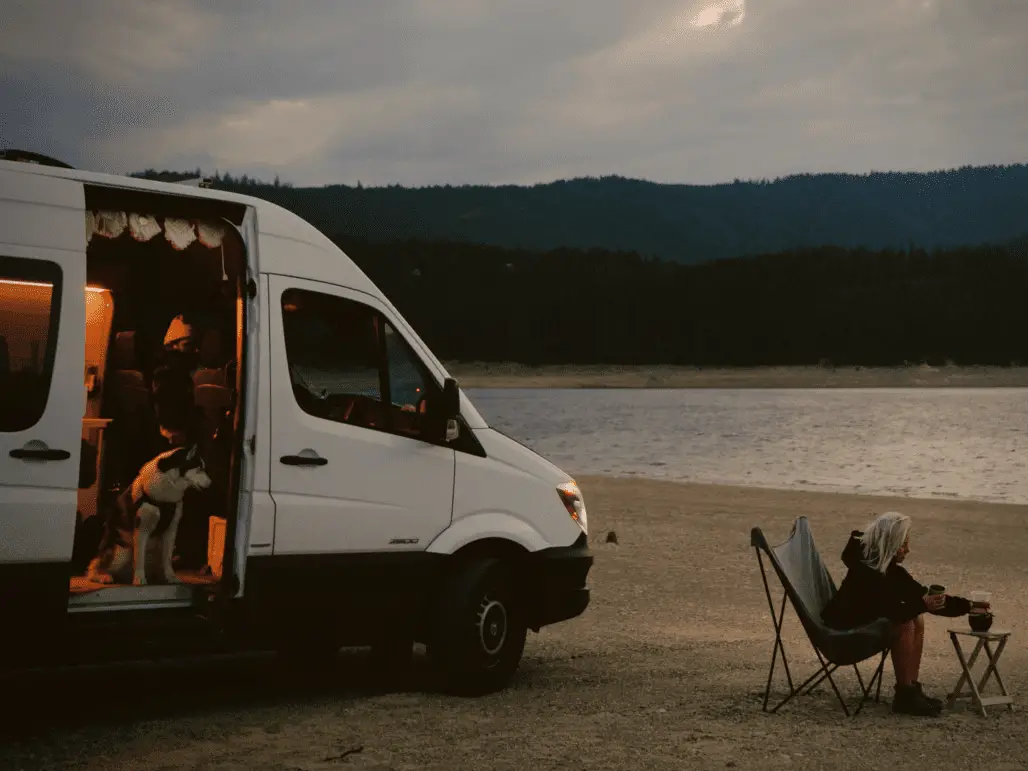RVing with pets adds companionship and fun to the road, but it requires extra planning. Dogs and cats have unique needs that can’t be ignored while traveling. With the right preparation, you can create a safe, stress-free, and memorable trip for both you and your furry friend. This guide covers everything you need — from planning and supplies to campsite etiquette and safety tips.
Planning Your Trip With Your Pet
Successful RV trips start with preparation. Before hitting the road, always check campground rules and local leash laws. Some destinations are pet-friendly, but others may limit access to trails or common areas. Therefore, doing research in advance prevents problems later.
Create a checklist of essentials: food, water, bowls, leashes, carriers, and medical records. In addition, add comfort items like blankets and favorite toys. You should also schedule breaks every two to three hours for bathroom stops and short walks. These pauses reduce stress for your pet and, as a result, help you travel more smoothly.
If hiking is part of your plan, confirm whether pets are allowed on the trail. Many national and state parks offer dog-friendly routes. However, some restrict pets altogether, so knowing where you can and cannot go ensures an enjoyable trip for everyone.
Benefits Of Traveling With Pets
Bringing your pet along offers more than companionship. Pets provide security and comfort, making the RV feel like home. In fact, long drives feel less lonely with a dog or cat by your side.
Other benefits include:
- Regular exercise during outdoor breaks
- Emotional support in new environments
- Opportunities to meet other pet owners at campgrounds
- A deeper bond through shared experiences
Traveling with pets is rewarding because both you and your companion can explore together. As a result, ordinary road trips turn into lasting memories.
Rules And Regulations
Every RV park or campground has different policies for pets. Some require proof of vaccinations, while others limit the number of pets per site. Always carry documentation, including rabies certificates and recent health records.
Expect rules about:
- Pets staying on a leash at all times
- Quiet hours (to minimize barking)
- Cleaning up waste immediately
- Restricted areas, such as swimming beaches or playgrounds
By following regulations, you not only avoid fines but also help keep campgrounds welcoming for future travelers with pets.
Supplies To Bring Along
Packing the right gear makes RVing with pets stress-free. Essential supplies include:
- Food and water: Pack enough for the full trip, plus extra in case of delays.
- Bowls: Collapsible bowls are lightweight and easy to store.
- Medications: Include flea and tick prevention, heartworm pills, and any prescriptions.
- Waste supplies: Litter boxes, bags, and scoopers for clean-up.
- Comfort items: Blankets, toys, and beds to keep pets relaxed.
- Safety gear: Seatbelt harnesses, crates, or carriers for travel.
In addition, extras like cooling mats in summer or jackets in winter help pets adjust to weather changes on the road.
Preparing Your Pet For The Trip
Acclimating your pet to the RV reduces anxiety. Let them explore the vehicle while parked, then try short drives before longer trips. For dogs, regular visits to fenced-in parks provide extra socialization. Meanwhile, cats may need additional litter, familiar bedding, and scratching posts to feel secure.
ID tags and microchips are non-negotiable. If your pet slips out, this identification ensures a higher chance of being found. Therefore, always keep recent photos handy too.
Proper Restraint And Leashes
Safety inside the RV is just as important as safety at campgrounds. Pets should never roam freely in a moving vehicle. Options include:
- Crash-tested harnesses clipped to seatbelts
- Secure crates or carriers
- Pet travel seats for small dogs
Using restraints not only prevents distractions for the driver but also protects pets in emergencies. In addition, make sure gear fits properly and doesn’t cause discomfort.
Veterinary Care On The Road
Schedule a checkup before leaving. Confirm your pet is healthy enough for travel and up to date on vaccinations. Carry a folder with medical records, prescriptions, and your vet’s contact details.
Also, research veterinarians and emergency clinics along your route. Having addresses and phone numbers ready can save valuable time. As a result, you’ll feel more confident while traveling through unfamiliar places.
Grooming Tips For Long Trips
Keeping pets clean makes travel easier. Brush coats often to reduce shedding inside the RV. Carry grooming wipes for quick cleanups after hikes or beach visits. Cats need enough litter to last the full trip, along with a mat to catch stray bits.
In addition, inspect your pet daily for ticks, sore spots, or paw injuries. A portable grooming kit with brushes, nail clippers, and towels helps you stay prepared.
Safety Tips For Your Pet
A safe journey requires planning. Always:
- Never leave pets unattended in a hot RV
- Use fans, AC, or shade for cooling
- Offer frequent water breaks
- Take rest stops every few hours
If your pet gets carsick, ask your vet about medication. On the other hand, if your pet shows signs of stress such as heavy panting or whining, adjust your travel schedule. This flexibility ensures their comfort and safety.
Activities For Your Pet
RV life isn’t just about the drive — it’s about adventure. Many campgrounds offer dog-friendly trails, agility courses, and open play areas. You can also explore nearby parks or beaches where leashed pets are welcome.
If you’re stuck indoors, try puzzle toys or short training sessions to keep your pet mentally stimulated. In addition, interactive play reduces boredom and improves behavior during long trips.
Dining Out With Pets
Many campgrounds and towns have outdoor dining areas that welcome pets. Before visiting, check local regulations. Also, bring collapsible bowls, water, and a mat so your dog can settle comfortably.
Be mindful of other diners. Keep pets leashed, discourage begging, and clean up any messes. As a result, restaurants remain open and friendly toward pet owners.
Campsite Etiquette
Respecting campground rules creates a better experience for everyone. Always:
- Pick up waste immediately
- Keep pets leashed unless in designated off-leash areas
- Prevent excessive barking
- Supervise pets around children and other animals
By following these tips, you not only protect your pet but also make fellow campers more welcoming.
Finding Pet-Friendly Attractions
With some research, you’ll find plenty of attractions that allow pets. Websites like BringFido and AllTrails list dog-friendly parks, hikes, and restaurants. Local tourism boards also provide lists of pet-friendly activities.
In addition, always carry essentials such as water, treats, and waste bags when visiting public spaces. A little preparation ensures pets can join you in more places.
Training Tips For Smooth Travel
Basic training reduces stress while RVing. Practice commands like “sit,” “stay,” and “heel” before your trip. These cues help in busy campgrounds or on crowded trails.
Establish routines for feeding, walks, and bedtime. Pets feel more secure when schedules stay consistent. Therefore, keeping structure during travel helps reduce anxiety.
Troubleshooting Common Problems
Even with preparation, issues may arise. If your pet seems anxious, increase exercise or provide chew toys for comfort. For motion sickness, shorter drives with gradual increases often help.
If problems persist, consult your vet for solutions. As a result, you’ll avoid frustration and keep the journey positive for both of you.
Frequently Asked Questions
How do I prepare my pet for long road trips?
Schedule a vet visit, pack medical records, and start with short practice drives. In addition, keep pets restrained and plan frequent breaks for water, food, and exercise.
What’s the safest way to restrain my pet?
Crash-tested harnesses, crates, or pet travel seats are the best options. Pets should never be loose in a moving RV. Therefore, always secure them before driving.
What should I pack for my pet?
Food, water, bowls, leashes, toys, medication, and waste supplies are essential. In addition, extras like cooling mats, jackets, or comfort items make travel smoother.
How do I find pet-friendly campgrounds?
Use sites like BringFido, campground directories, or state park websites. Also, check rules before booking to avoid surprises.
Final Thoughts
RVing with pets can be rewarding and stress-free when you prepare. From packing the right gear to respecting campground rules, each step keeps your pet safe and happy. With the right planning, your dog or cat becomes more than a passenger — they become your adventure partner.

